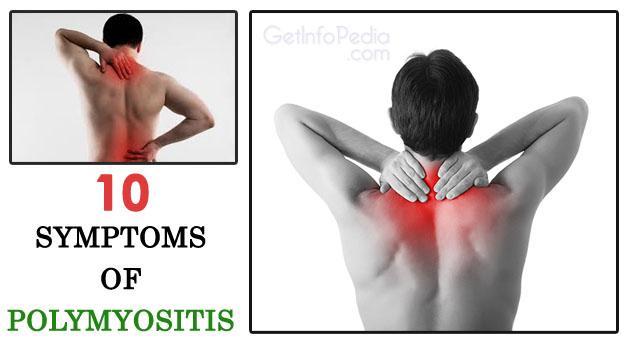Chronic inflammation of the muscles characterizes the condition of Polymyositis. Inflammation found mostly in the endomysium, it is the smallest and deepest component of the muscle connective tissue. According to studies, it is a cytotoxic process mediated by a T-cell, directing it against muscle antigens. Women tend to suffer more due to this than men. It is the most common among 20 year-olds and finds its peak incidence in people aging from 45-60 year old.
1.Muscle Weakness
Muscle weakness, also known as myasthenia, can be short or long-lived based on the cause and proper treatment that the patient can receive. The muscle weakness in polymyositis is often found in the proximal muscles which is bilateral. This can cause the patient problems in getting up while they are seated or even to raise their arms.
2.Myalgia
Myalgia is the term that is used to refer to muscle pain that shows its presence in various conditions like overuse or overstretching, side effect of medications, viral infections, autoimmune disorders, potassium deficiency, fibromyalgia, polymyositis.
3.Dysphagia
The difficulty one faces while swallowing something can be termed as dysphagia. A higher risk of a disease called aspiration pneumonia is found commonly among patients suffering from dysphagia. It has the potential to lead to malnutrition, renal failure, and dehydration, if left undiagnosed. The symptoms of dysphagia includes the inability to control saliva or food in one’s mouth, having trouble or being unable to initiate a swallow, coughing, choking, regurgitation, weight loss, and wet voice. They also suffer a lot from pneumonia.
4.Aspiration
In polymyositis, issues with esophageal motility and dysphagia increases the risk of aspiration. In polymyositis, esophageal motility increases besides dysphagia. This duo complements the increase in risk of aspiration in patients. Aspiration is the coincidental entry of food materials, contents of the stomach, or secretions into the lower respiratory tract and larynx.
5.Loss of appetite
Loss of appetite or anorexia is commonly present in many conditions. However, it is non-specific. Some causes of anorexia include anxiety, atypical pneumonia, appendicitis, chronic kidney disease, cancer, heart failure, dehydration, dementia, hypothyroidism, depression, metabolic disorders.
6.Fatigue, or the feeling of being tired
can be overcome with sufficient rest. A common symptom, this can be seen in situations revolving around inadequate sleep, stress, nutritional deficiency, overworking, infections, and dehydration, besides many more. In polymyositis, physical fatigue occurs often as a direct consequence of bilateral proximal muscle weakness, which causes a patient trouble in carrying out his or her daily activities.
7.Fever:
Fever finds steady occurrence when the temperature of the body increases beyond what it should be. In small children, fever is capable of leading to febrile seizures. However, fever can be combatted with medicines like Paracetamol (acetaminophen) and NSAIDs such as diclofenac sodium. Ibuprofen, and naproxen sodium can also be of benefit to the patient. Fever is quite commonly noticed, however non-specific a symptom, in various cases like viral, parasitic infections, bacterial, or dehydration conditions. It is also commonly seen in inflammatory conditions.
8.Weight Loss
Weight loss is the term that is used to define the loss in body mass as a result of the decrease in muscle, fluids, body fat, mineral deposits, or some connective tissues. Unintentional weight loss may have nutritional deficiency or some underlying disease as the reasons working behind it. The other reasons behind losing weight can be not enough food intake, improper digestion and absorption of food, changes in the body due to metabolic demands, or loss of nutrients in excess amounts.
9.Arthralgia:
Arthralgia is a medical term used to describe joint pain. It is usually a symptom of infection, injury, illness, or allergy to medication. Some of the causes of arthralgia include systemic lupus erythematosus, viral arthritis, rheumatoid arthritis, osteoarthritis, gout, septic arthritis, hemarthrosis, and more.
10.Joint stiffness:
Joint stiffness refers to the pain a patient experience while trying to move. Joint stiffness can also be associated with restricted motion. When the motion is constrained, movement is longer normal. Difficulty in moving the joints that may or may not be associated with swelling is also a notable symptom.


Comments